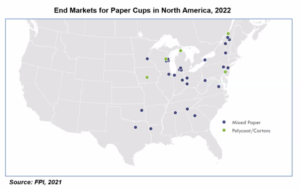Why aren’t paper cups recyclable or compostable if they are made from paper?

March 3, 2022//Comments Off on Why aren’t paper cups recyclable or compostable if they are made from paper?
 As events and activities pick up around Central Oregon with spring approaching, community members and businesses frequently ask about recycling and composting paper cups. Why aren’t paper cups recyclable or compostable if they are made from paper? The short answer is – paper cups are not recyclable or compostable because they are not made of just paper. Paper cups are designed to hold hot or cold liquids without absorbing the liquids, leaking, or falling apart. So the vast majority of paper cups are coated in plastic or wax (i.e., waterproofing).
As events and activities pick up around Central Oregon with spring approaching, community members and businesses frequently ask about recycling and composting paper cups. Why aren’t paper cups recyclable or compostable if they are made from paper? The short answer is – paper cups are not recyclable or compostable because they are not made of just paper. Paper cups are designed to hold hot or cold liquids without absorbing the liquids, leaking, or falling apart. So the vast majority of paper cups are coated in plastic or wax (i.e., waterproofing).
This thin coating on coffee, soda, and other paper cups is not easily separated from paper in the recycling process. “Wishcycling” paper cups into our mixed recycling bins, increases operating costs and contaminates other truly recyclables material recovery facilities (MRFs). The lining (even if it is bio-based) cannot be broken down into nutrient rich soil, making it unsuitable for compost that is used by local farmers and gardeners. Here are nine reasons “compostable” serviceware is not accepted by local composters.

Paper cup recycling is available in some communities where they have access to infrastructure, technology, and resources to collect, bail, and separate out the lining. One reason, paper cup recycling would not be efficient here in Central Oregon is that we are far from end markets for paper cup fiber that buy and turn the fiber into new products (see the map of paper cup end markets in 2022). Even in communities where where paper cup recycling takes place by separating out the plastic lining and drying it into a more transportable and usable form, this plastic is often discarded into landfills or burned as a coal alternative.

I think this is another great reminder of why we should do our best to reduce and reuse instead of relying solely on recycling. So, please continue to place paper cups in the landfill bin. Opt for reusable cups instead to conserve energy and resources upstream, and keep materials out Knott Landfill.